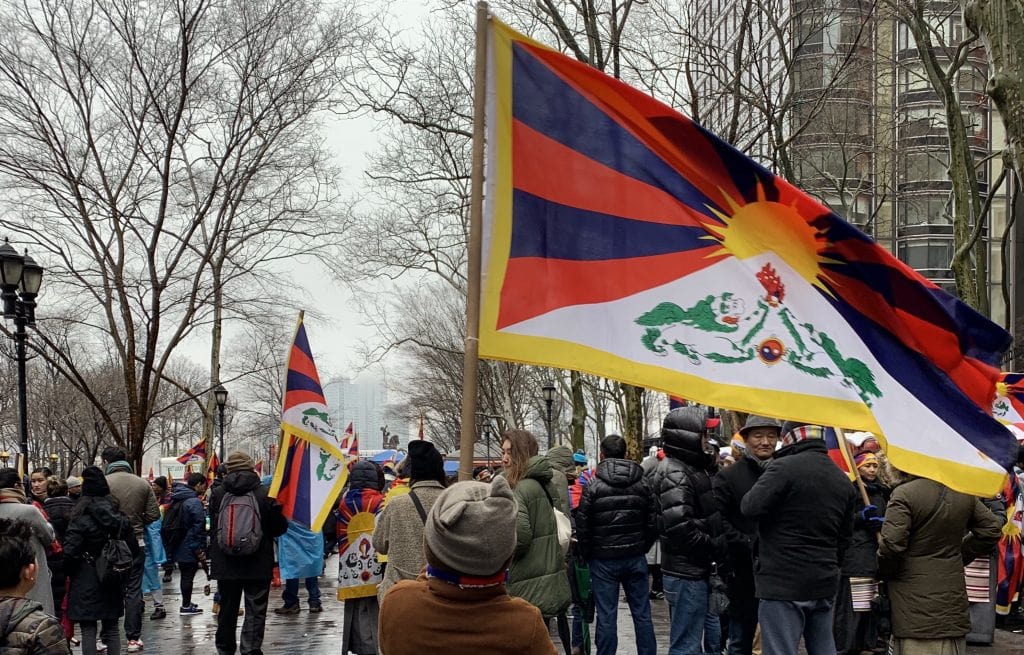American Nomads: Tibet’s hyphenated youth activists
American Nomads: Tibet's hyphenated youth activists

In 1985, there were barely more than 500 Tibetans in the entire US. The most recent census, taken in 2008, estimated the Tibetan population in America at 9,000. Sonam Wangdu, who helped establish the US Tibet Committee (the first Tibet support group) in the 1970s, came to the US as a student in 1964, making him one of the first Tibetan-Americans. Sixty years after the first Tibetan uprising on March 10, 1959, Wangdu says the numbers are contested at 10,000 overall while he’s heard others say 10,000 makes up the Tibetan population in the New York area alone. The United States is home to the largest Tibetan diasporic community outside of India and Nepal, and although Wangdu can’t confirm the numbers, he says it’s clear that the population is quickly growing. And as those numbers grow, so does a new generation of Tibetan-Americans who are carrying on the nonviolent fight for a free Tibet.
Growing up Tibetan, you become acquainted with politics at a young age. You learn to recognize yourself as the descendent of a people wrongfully removed from their homeland, are forced to acknowledge the horrors they endured and continue to endure, feel the weight of their suffering fall on your shoulders and dream of going home to a place you’ve never been. Growing up Tibetan in America, the land of opportunity, you’re expected to do something about it.
“I think right now is the time for us,” Sonamtso, a Tibetan-American from San Francisco and communications director of the Tibet support group, Students for a Free Tibet says. “Not only as folks brought up in a generation where we still have that connection to Tibet but also having been brought up with a greater global understanding.”
Politics of culture
As a kid, politicking took the form of attending language-and-culture classes on the weekends and travelling to whichever nearby city was holding a Free Tibet rally. It looked like wearing yak-wool dresses (intended for Himalayan climates) under hot stage lights and trying not to topple over while balancing ten pounds of coral and turquoise around your little head and neck during dress rehearsals. It was fumbling around on stage as you sang and danced to traditional Tibetan music for awing and unfamiliar crowds who thought you were adorable. Culture isn’t always political, but it certainly is to China.
Since China’s invasion of Tibet in 1950, Tibetans within Tibet have been denied the rights to religion, speech and assembly, and are systematically oppressed from speaking their native language. In Tibet, the Tibetan flag and national anthem are banned. Those who dissent are labeled separatists, arrested, often tortured and even killed for celebrating their ethnic identities. The human rights advocacy group, Freedom House has ranked Tibet as one of the world’s worst places for human rights violations for the past three years.
“When your identity — your personhood, your ability to be who you want to be — is in peril, culture is a very fundamental place to root your activism,” Dr. Julia M. Hess, an anthropologist at the University of New Mexico and author of “Immigrant Ambassadors: Citizenship and Belonging in the Tibetan Diaspora” says.
Tshedzom Tingkhye grew up going to Free Tibet marches and participating in countless cultural performances. But sometime in her late teens, she started to distance herself from participating in the Tibetan community, saying it felt like something she had to do but didn’t understand why. The Vice President of the International Campaign for Tibet, Bhuchung Tsering says it’s necessary to have a deep understanding and investment in Tibet’s issues to be an effective activist. “Otherwise, it becomes like a checklist. You go out on a rally and a march and you’ve done your civic duty.”
When Tingkhye moved across the country for school last fall, she left behind her connection to the Tibetan community, leaving a void where she didn’t expect one. Now, a 21-year-old dance student at the Boston Conservatory, she’s looking for ways to incorporate her Tibetan identity into her choreography and raise awareness about Tibet through her art. “People in Tibet can’t sing their own songs, they don’t have that basic right and I do,” she says.
Molly Chatalic, a professor of American cultural studies at the University of Western Brittany and the author of “Tradition and Identity among Tibetan Americans,” says Tibetans are more aware of their culture and identity than ever because of China’s efforts to repress them. Eradicating Tibet’s rich culture is China’s only hope to crush the Tibetan freedom movement. That said, the preservation of their culture is where Tibetans hang their hopes for a free Tibet.

Criticism to follow
This is precisely what makes ‘not preserving your culture’ such a taboo in the Tibetan community. Since the Tibetan identity hinges on its culture, there’s a great pressure on young Tibetans to uphold the notion of what it means to be a ‘real Tibetan’ maintained by much of the older generation, accompanied by a lot of criticism when you don’t. Not speaking Tibetan or spending too much time out of the house could get you called injee, meaning American, white or generally not Tibetan.
Hess said this is the case for many immigrants: “Even if they’ve only been here a few months, they get it. They see how American culture is so individualizing and they see it as such a threat to everything — their way of raising their kids and their understanding of how the world works.”
My father was born in Tibet and grew up in India. He has lived in the US since 1979, but even after 40 years, he still doesn’t consider himself an American. “I’m Tibetan,” he said. “A two-time refugee.” America is not home but a place of refuge for him. To hyphenate your identity with ‘American’ is often perceived as a dig to your loyalty to Tibet by community members, and as youth, it isn’t uncommon to have older Tibetans ask which title you identify more with.
“They love to ask that because they want us to be like ‘I’m Tibetan first!’” Choetso Amnyetsang, a 27-year-old Tibetan-American from Portland, Oregon said. “I don’t feel like being an American requires you to choose.”
According to a study by University of Victoria sociologists, first-generation immigrants tend to prefer national-origin identities as opposed to the second generation, which tends towards hyphenated titles, suggesting that multicultural environments like the US promote the retention of one’s culture as well as a sense of belonging to the host nation. For the many young Tibetans like myself who’ve grown up in the States, Tibet is the place that lives in our minds while America is the only home we’ve known.
Parents of American-born Tibetans often compare their kids to their own youth or to the Tibetans growing up in the exiled communities of India. “The bottom line is we’re not there. We didn’t have that upbringing and we have an incredibly different set of challenges here,” Amnyetsang said. Many Tibetan elders tend to criticize youths who don’t speak Tibetan well as being less Tibetan than those who do. Amnyetsang, who is the vice president and assistant educational director of the Northwest Tibetan Culture Association, works with many of the new language-and-culture class students and hopes to dispel cultural expectations like this.
“When kids are told that them not speaking Tibetan is a huge deficit in their morality or character, I think it’s super f–ked up because they have to assimilate to being a part of mainstream culture and a lot of it discourages you from embracing your own culture. And that’s something that not many young people are equipped to do.” Wangdu, who keeps Tibetan diplomacy at the front of his mind, considers these disparaging comments to be unhelpful and alienating to young people.
Amnyetsang has always been heavily involved with the Tibetan cause. By 14, she was going beyond the obligatory March 10th rallies and Tibetan school attendance to create her own events to support Tibet, but she eventually had to step away for some time. There was too much pressure and input from too many people, and she burned out.
“The trope that young people are the future is,” Hess hesitates to say, “messed up.” She understands why, noting the complexity and urgency of the situation, but thinks it’s a big burden for young people.

Commitment to the cause
Nagwang Gyamtso is a junior at Syracuse University from New York City. Unlike many Tibetan-American youths, he wasn’t very active within the community growing up, never going to Tibetan school, rallies or spending much time with other Tibetans. It wasn’t until recently — this year, in fact — that Gyamtso, embarrassed to admit, began to feel a sense of personal responsibility to Tibet. He needed to learn more about the situation in his ancestral homeland, realizing he knew little besides the fact that there were human rights violations taking place. He describes a few nights of research, pouring over articles that sat uneasy in his mind, and the guilt that followed for not being more involved with the cause.
“Because I’m here, right? I’m over here in America where I can make a difference.”
Unlike previous generations, a majority of whom were refugees, today’s generation in the West is quickly gaining citizenship in its countries of residence. “It’s for these people to realize their identity as citizens of their respective countries and see how well they can use the political process in those countries to encourage conversations on the issue of Tibet,” ICT’s Tsering says.
This is that big burden Hess was talking about: “It’s like you’re afforded the privilege of being born in the US, but then that gives you a responsibility to something larger than yourself.”
Despite the criticism, the pressure and the obligation we feel to a land we’ve only known through songs and stories, Tibetan-Americans are just as committed to the cause. Wangdu said most of the Tibetan activists he sees nowadays are people who were born in the West and have never seen their parent’s homeland.
Gyamtso is studying abroad in Hong Kong next semester and recently asked his advisor if he’d be able to visit Tibet. She told him it would be difficult — but he feels hopeful, mentioning the Reciprocal Access to Tibet Act of 2018 that was passed at the beginning of the year and aims to provide American citizens with greater access to Tibet.
Tenzin Losel, who is also from New York and attends Syracuse University, is Gyamtso’s fraternity brother, housemate and friend. He was an active member of Students for a Free Tibet when we was in high school and heavily engaged with the community as a teen. He hasn’t had much of an opportunity to involve himself with the Tibetan cause in college, but has always known that whatever profession he pursues will ultimately be to help Tibet.
The two of them sit around their living room that’s lightly littered with leftover food and half-crushed beer cans — not an unusual site for an American fraternity house. Gyamtso asks why he found Losel’s chuba (traditional Tibetan robe) on his bed the other day. Losel, a theatrically exaggerated 22-year-old, said he was sleeping in it the other night, laughing between his explanations. “I was imagining this is probably how they must’ve slept, you know, our ancestors somewhere up in the mountains.” There aren’t more than a handful of Tibetan students at Syracuse University, nor a nearby community or Tibet support groups on campus, but he says he brought it just in case. I asked Losel, who has never been to Tibet, if he wanted to go.
“Hell yeah. What??” he scoffed at me, with a look that said why’d you even ask. Hell yeah, he repeats. “I want to go there, touch the land, kiss it, roll around on the grass!” In contrast to Gyamtso, whose enthusiasm for Tibet is less animated, Losel is having fun getting lost in the daydream that Tibet has become for so many of us.
“Can you imagine?”





